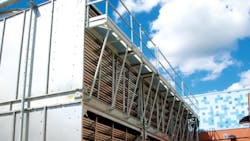What Owners Need to Know About ... Evaporative-Cooling Equipment
Evaporative-cooling equipment is selected to provide a fluid (usually water) to a system at a certain temperature and flow rate. If the temperature of the fluid delivered to a system (chiller) is higher than desired, the system will suffer increased wear and tear and usage. Decreasing leaving-water temperature by just 2°F can lower electricity expenditures by 6 percent.
Routine inspection and maintenance is paramount in achieving desired temperature and flow rate, and it plays an important role in extending operating life. Maintenance frequency depends mainly on the condition of the circulating water and the environment in which a unit is operating. This article provides general guidance regarding periodic inspection and maintenance.
Monthly
Every month:
- Inspect the overall condition of the unit, paying close attention to any unusual noise or vibration.
- Inspect and clean dirt and debris from the cold-water basin.
- Inspect the air-intake louvers or combined inlet shields for debris.
- Check and adjust the water level in the cold-water basin.
- With belt-drive units, inspect the physical condition of the belt. With gear-drive units, check the oil levels weekly (or as directed in the owner’s operating manual).
Quarterly
Quarterly maintenance is recommended as follows:
Cold-water basin. Flush dirt and debris from the cold-water basin through the tower drain or sump strainer. With the installation of basin-sweeper piping and a filtration system, this maintenance can be performed automatically.
Sump strainers should be inspected routinely and cleaned to keep debris from reaching the pump.
The makeup-water system replaces lost water via a mechanical float ball and valve assembly or an electric water-level probe assembly with solenoid valve. Inspect mechanical float assemblies for leaks, proper operation, and water level, and make necessary adjustments. Inspect and clean electronic water-level probes periodically to prevent scale, corrosion, sludge, or biological growth, which could interfere with the electrical circuit. Makeup-water supply pressure typically should be maintained between 15 and 50 psig to ensure proper valve shutoff and avoid chatter. If supply pressure is higher than 50 psig, install a pressure-reducing valve.
Water distribution. Check to ensure water is distributed evenly over the wet-deck-fill section or coils section. If dry areas are visible, clean or replace nozzles as necessary. Broken or clogged nozzles cause uneven water distribution over the fill or coil section, scale buildup, and a decrease in capacity.
Mechanical drive systems. A mechanical drive system has several components operating at high speed that should be checked regularly. Check the general condition of the fan and fan shaft. Cooling-tower fans typically are driven by belt- or gear-drive system, both of which require routine maintenance to ensure reliable and trouble-free performance.
With belt-drive systems, proper belt tensioning is critical to ensuring reliable operation (see “Ensuring Proper Fan-Belt Tension” by Brian Mleziva, July 2011).
With a gear-drive system, oil level, oil quality, and shaft alignment should be checked regularly and in accordance with the manufacturer’s recommendations.
Fan-shaft bearings should be lubricated every three months at a minimum.
Some fan motors may require motor-bearing lubrication as recommended by the manufacturer. For maximum life and fewer motor failures, install motors with a “cooling-tower-duty” rated motor.
Safety and Access
Safety and access options for evaporative cooling towers are highly recommended to help facilitate inspection and maintenance. The less accessible equipment is, the less likely it is to be maintained.
Replacement Components
Regardless of how often routine maintenance is performed, problems may arise. It is recommended that items critical to the operation of your unit be kept in your inventory to minimize downtime.
Conclusion
Proper maintenance ensures a unit will operate as designed and extend the life of the unit. Additional energy savings can be achieved by increasing the performance of the unit through retrofits and upgrades. Up to 10-percent energy savings can be achieved by upgrading and replacing nozzles, replacing drive components, or installing new fill.
June Galloway has been with Baltimore Aircoil Co. for more than 15 years. She can be contacted at [email protected].
Did you find this article useful? Send comments and suggestions to Executive Editor Scott Arnold at [email protected].
